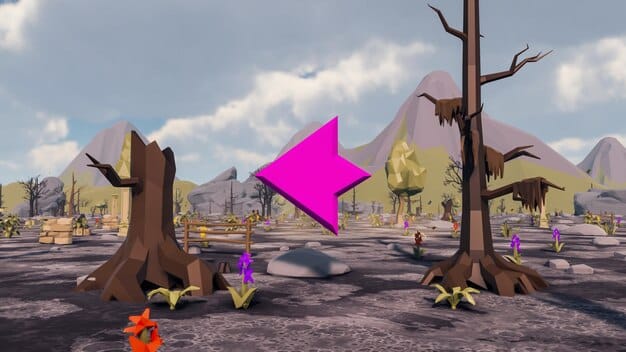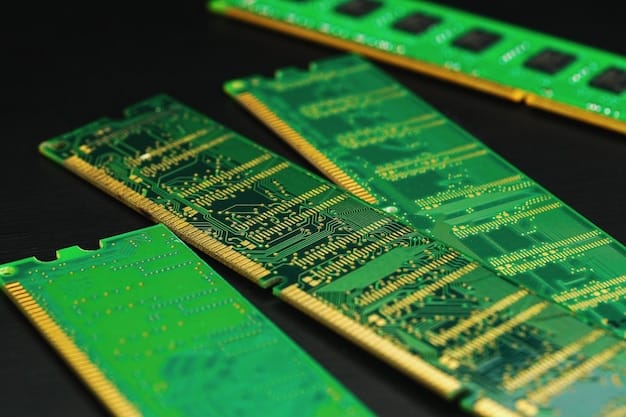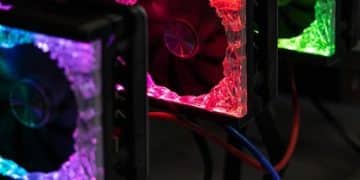Ray Tracing Explained: What It Is & How It Impacts Gaming

Ray tracing is an advanced rendering technique that simulates the physical behavior of light to create realistic and visually stunning graphics in video games, significantly impacting the gaming experience and performance requirements.
Ever wondered how video games achieve those breathtakingly realistic lighting effects? The answer often lies in what is ray tracing, and how does it affect gaming performance? Let’s dive into this cutting-edge technology and explore its impact on your gaming experience.
Understanding Ray Tracing Technology
Ray tracing is a rendering technique used in computer graphics to simulate the way light behaves in the real world. It works by tracing the path of light rays from the viewer’s eye through the scene, calculating how they interact with objects, and determining the color and brightness of each pixel.
How Ray Tracing Works
Unlike traditional rasterization techniques, which estimate lighting effects, ray tracing accurately simulates reflections, refractions, shadows, and global illumination. This results in more realistic and visually appealing scenes.
The process involves casting rays from the camera into the scene. When a ray intersects with an object, the algorithm calculates how the light would bounce or be absorbed, taking into account the properties of the material and the surrounding light sources. This is computationally intensive but yields incredibly realistic results.
- Ray Casting: Traces rays from the camera to the scene.
- Intersection Calculation: Determines where the rays intersect with objects.
- Light Interaction: Calculates how light bounces and interacts with surfaces.
- Pixel Rendering: Assigns color and brightness to each pixel based on light interaction.
Ray tracing can dramatically enhance the visual fidelity of games by creating more believable and immersive environments. While it demands significant processing power, advancements in hardware and software optimization are making it increasingly accessible.
The Visual Benefits of Ray Tracing in Games
Ray tracing offers several visual advantages over traditional rendering methods, transforming the gaming landscape with its realistic lighting and rendering capabilities. By accurately simulating light behavior, it significantly enhances the overall visual experience.

Enhanced Reflections and Shadows
One of the most noticeable improvements with ray tracing is the quality of reflections and shadows. Traditional methods often approximate these effects, leading to unrealistic or flat-looking visuals. Ray tracing, on the other hand, creates accurate and dynamic reflections that respond to the environment in real-time.
Shadows are also rendered more realistically with ray tracing. Instead of simple, hard-edged shadows, ray tracing produces soft, penumbral shadows that mimic how light scatters in the real world. This subtle detail adds depth and realism to the game environment.
Improved Global Illumination
Global illumination (GI) is another area where ray tracing shines. GI refers to the way light bounces and scatters throughout a scene, affecting the overall brightness and color of objects. Ray tracing accurately simulates these light bounces, resulting in more natural and cohesive lighting.
- Realistic Reflections: Accurate reflections off reflective surfaces.
- Soft Shadows: Penumbral shadows that add depth.
- Natural Lighting: Improved global illumination for realism.
- Immersive Environments: Enhances visual fidelity.
These visual enhancements combine to create gaming environments that are more immersive and believable. Ray tracing brings a new level of realism to the gaming experience, making virtual worlds feel more alive.
Ray Tracing and Gaming Performance: The Trade-off
While ray tracing offers significant visual improvements, it also introduces a performance challenge. The complex calculations required to simulate light behavior can be demanding on hardware, leading to a trade-off between visual quality and frame rates.
Impact on Frame Rates
Activating ray tracing can significantly reduce frame rates, especially on less powerful hardware. The more advanced ray tracing effects used in a game, the greater the performance impact. This is because ray tracing requires a substantial amount of processing power from the GPU.
Gamers often need to choose between enabling ray tracing and maintaining a smooth, playable frame rate. For some, the visual enhancements provided by ray tracing are worth the performance cost, while others prefer to prioritize higher frame rates for a more responsive gaming experience.
DLSS and Performance Optimization
To mitigate the performance impact of ray tracing, technologies like NVIDIA’s Deep Learning Super Sampling (DLSS) have emerged. DLSS uses artificial intelligence to upscale lower-resolution images, improving performance while maintaining visual quality.
- Performance Cost: Ray tracing can reduce frame rates.
- Hardware Demands: Requires powerful GPUs.
- DLSS: AI upscaling to improve performance.
- Optimization: Game developers optimize ray tracing for better performance.
Game developers also play a crucial role in optimizing ray tracing implementation to minimize its performance impact. By carefully selecting which effects to apply and fine-tuning the algorithms, they can find a balance between visual quality and performance.
Hardware Requirements for Ray Tracing
Running ray tracing effectively requires specific hardware capabilities. Not all GPUs are created equal when it comes to handling the complex calculations involved in simulating light behavior. Understanding the hardware requirements is crucial for gamers looking to experience ray tracing in their favorite titles.

NVIDIA RTX and AMD Radeon RX Series
NVIDIA’s RTX series of graphics cards were among the first to offer dedicated hardware for ray tracing. These cards include RT Cores, which are specialized units designed to accelerate ray tracing calculations. Similarly, AMD’s Radeon RX series also supports ray tracing, offering hardware acceleration for these effects.
For optimal ray tracing performance, a high-end GPU from either the NVIDIA RTX or AMD Radeon RX series is recommended. These cards provide the necessary processing power to handle the demands of real-time ray tracing.
CPU and Memory Considerations
While the GPU is the primary component for ray tracing, the CPU and memory also play a role. A powerful CPU can help with scene management and other tasks, while sufficient memory ensures that the GPU can access the data it needs without bottlenecks.
- RTX and Radeon RX: GPUs with dedicated ray tracing hardware.
- High-End GPU: Recommended for optimal performance.
- CPU and Memory: Important for overall system performance.
- Driver Updates: Keep drivers updated for the best experience.
Additionally, keeping your graphics drivers updated is essential. Driver updates often include optimizations and improvements that can enhance ray tracing performance and stability.
Ray Tracing in Popular Games
Ray tracing has been implemented in a variety of popular games, showcasing its potential to transform the gaming experience. From realistic reflections in Cyberpunk 2077 to enhanced shadows in Metro Exodus, ray tracing adds a new layer of visual fidelity to these titles.
Cyberpunk 2077 and Control
Cyberpunk 2077 is one of the most notable examples of ray tracing implementation. The game features realistic reflections, shadows, and global illumination, creating a visually stunning and immersive open-world environment. However, it’s also known for its high hardware requirements when ray tracing is enabled.
Control is another game that makes excellent use of ray tracing. The game features dynamic reflections and lighting effects that enhance the surreal and atmospheric environments. Ray tracing adds a sense of depth and realism to Control’s unique visual style.
Other Notable Titles
Other games that support ray tracing include:
- Metro Exodus: Enhanced shadows and global illumination.
- Battlefield V: Realistic reflections in water and on metallic surfaces.
- Call of Duty: Modern Warfare: Improved shadows and ambient occlusion.
As ray tracing technology continues to evolve, more games are expected to incorporate these effects. The future of gaming graphics is likely to be heavily influenced by ray tracing and other advanced rendering techniques.
The Future of Ray Tracing in Gaming
Ray tracing is poised to play a significant role in the future of gaming graphics. As hardware becomes more powerful and software optimization improves, ray tracing will become more accessible and widespread. This will lead to even more visually stunning and immersive gaming experiences.
Advancements in Hardware and Software
Future GPUs are expected to feature even more powerful ray tracing hardware, allowing for more complex and realistic effects. Additionally, software optimization techniques, such as improved AI upscaling and better ray tracing algorithms, will help to mitigate the performance impact.
The integration of ray tracing into game engines like Unreal Engine and Unity will also make it easier for developers to incorporate these effects into their games. This will lead to a broader adoption of ray tracing across the industry.
Potential for Virtual Reality and Other Applications
Ray tracing also has the potential to enhance virtual reality (VR) experiences. By creating more realistic and immersive environments, ray tracing can make VR games and applications feel more believable.
- More Powerful Hardware: Future GPUs will enhance ray tracing.
- Software Optimization: Improved ray tracing algorithms.
- Integration with Game Engines: Easier implementation for developers.
- VR Applications: Enhancing virtual reality experiences.
Beyond gaming, ray tracing can be used in other applications, such as architectural visualization, film production, and scientific research. Its ability to accurately simulate light behavior makes it a valuable tool for a wide range of industries.
| Key Point | Brief Description |
|---|---|
| ✨ Ray Tracing Definition | Advanced rendering technique simulating light behavior for realistic graphics. |
| 🎮 Visual Benefits | Enhanced reflections, shadows, and global illumination for immersive gaming. |
| 📉 Performance Impact | Can reduce frame rates; technologies like DLSS help mitigate this. |
| 🚀 Hardware Requirements | NVIDIA RTX and AMD Radeon RX series GPUs are recommended. |
Frequently Asked Questions
▼
The primary benefit is enhanced visual realism. Ray tracing accurately simulates light behavior, leading to more lifelike reflections, shadows, and overall lighting in game environments.
▼
Ray tracing can significantly reduce frame rates because it requires substantial processing power. Technologies like NVIDIA DLSS help to mitigate this impact by upscaling lower-resolution images.
▼
NVIDIA’s RTX series and AMD’s Radeon RX series of graphics cards are recommended, as they have dedicated hardware for ray tracing. A powerful CPU and sufficient memory are also beneficial.
▼
Yes, ray tracing can enhance VR experiences by creating more realistic and immersive environments. This can make VR games and applications feel more believable and engaging for users.
▼
Yes, several games support ray tracing, including Cyberpunk 2077, Control, Metro Exodus, Battlefield V, and Call of Duty: Modern Warfare, among others. The list continues to grow as technology evolves.
Conclusion
In conclusion, what is ray tracing, and how does it affect gaming performance is a complex question with a multifaceted answer. Ray tracing offers significant visual enhancements, bringing a new level of realism to gaming experiences, but it also presents performance challenges. As hardware and software continue to improve, ray tracing is poised to become an integral part of the future of gaming graphics, offering more immersive and visually stunning worlds for gamers to explore.





